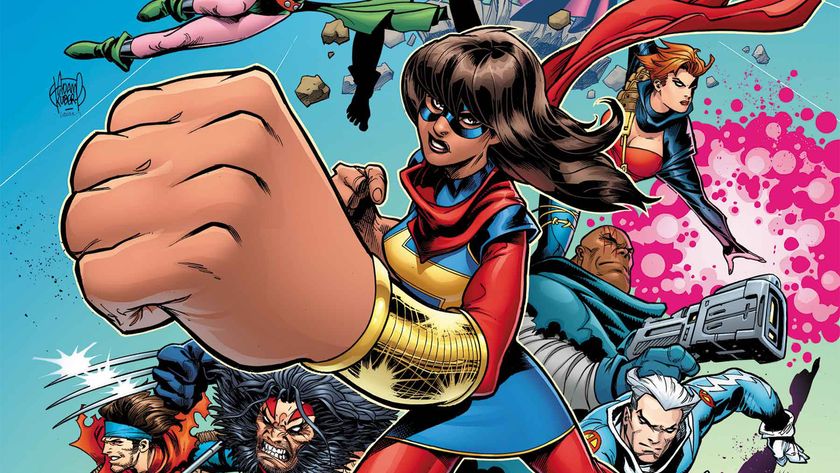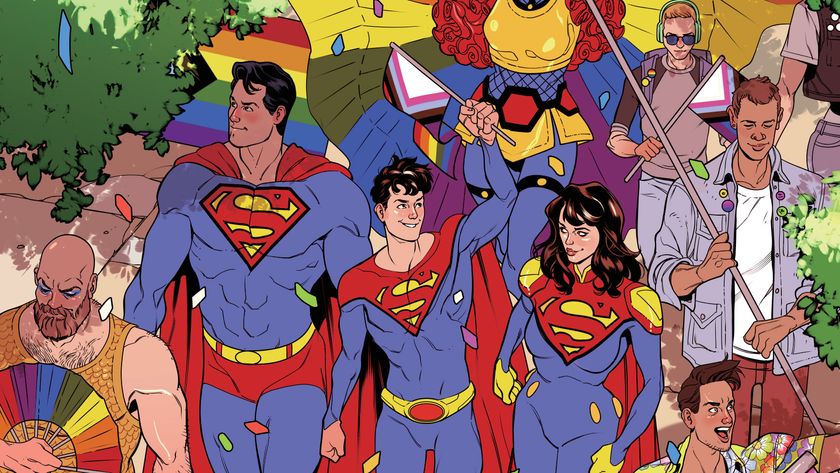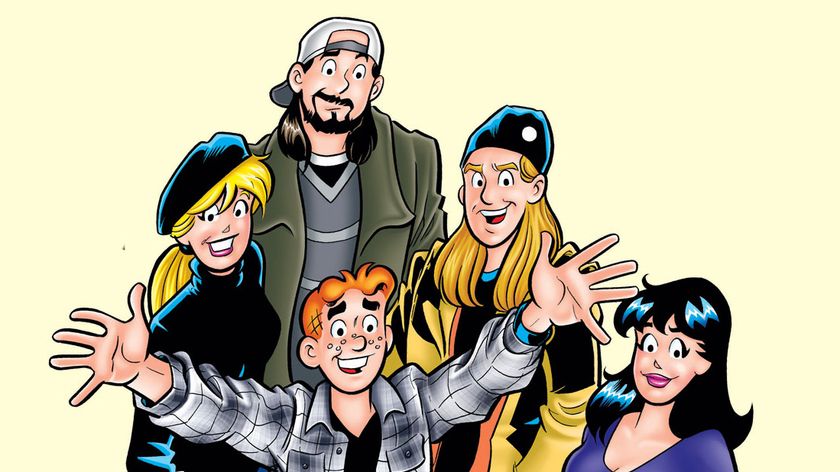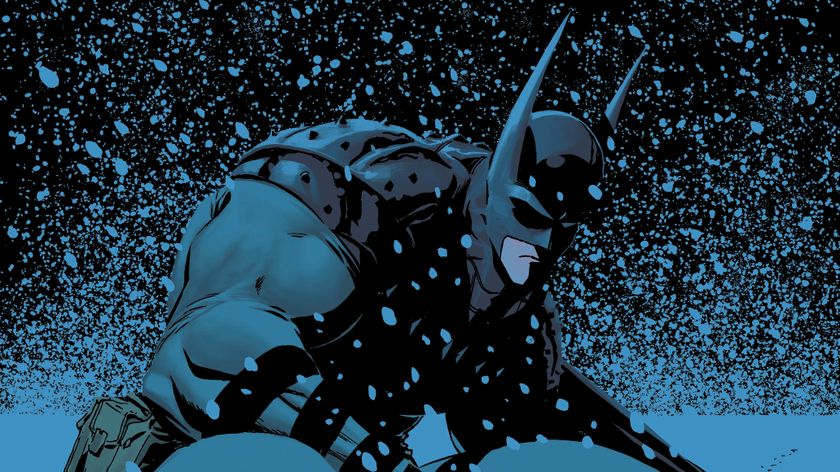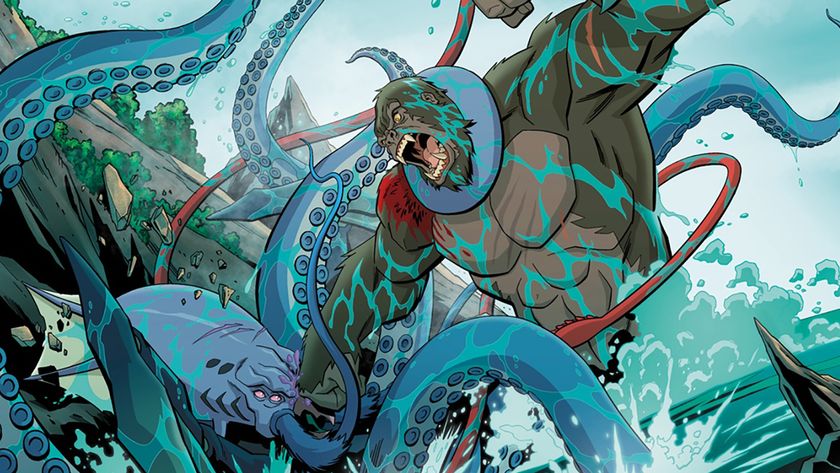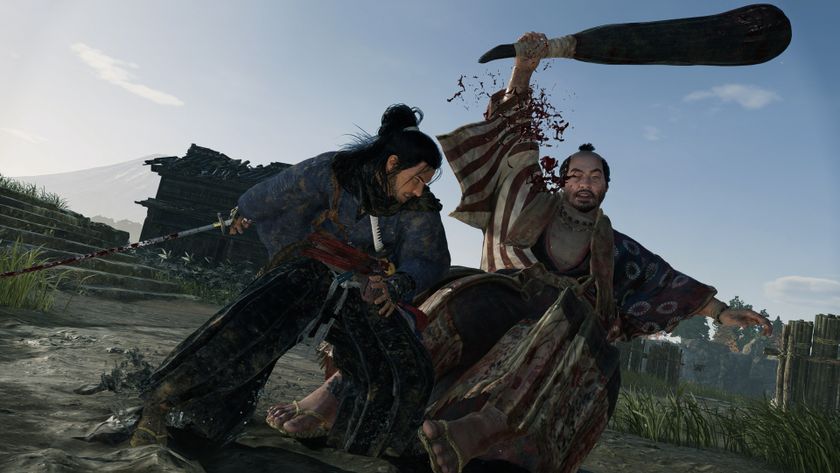Court of Owls creators revisit classic DC storyline rumored to inspire WB's new Batman game
Scott Snyder and Greg Capullo look back at the origins of 'The Court of Owls'
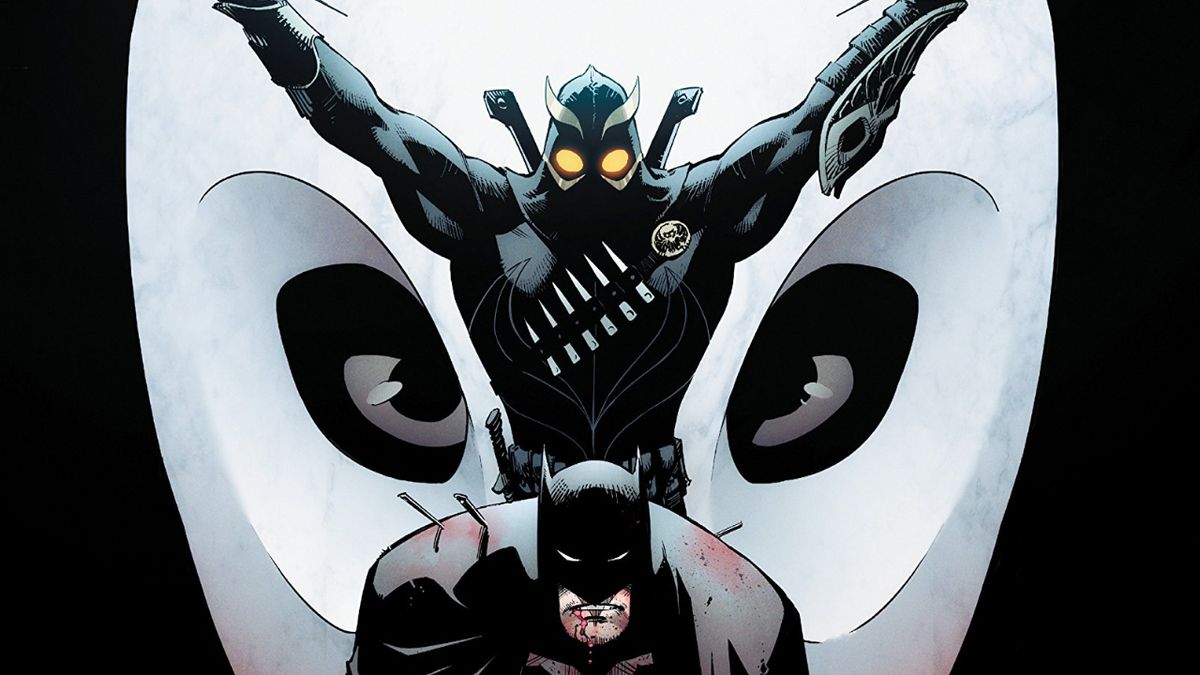
DC's 'New 52' era has come and gone, but arguably the most resounding impact - and critical success - of that time was Scott Snyder and Greg Capullo's Batman run.
And it began with an opening story arc called 'The Court of Owls.'
Batman thought he knew Gotham City like the back of his hand, but that 2011-2012 storyline revealed old wounds the city carried for generations - one that connects to not only the Wayne family but to Dick Grayson as well. And as Snyder tells Newsarama, the storyline was inspired by his own feelings about growing up in New York City and how it's changed and his own feelings of inadequacy in taking on DC's flagship title and kicking off a bold, line-wide retcon of the DCU as a whole.
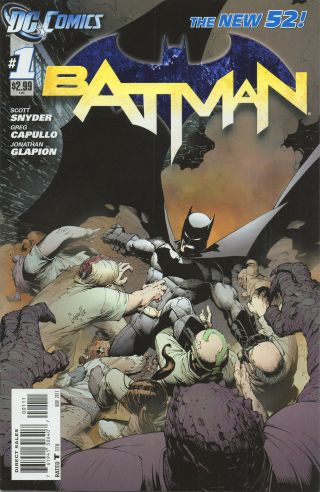
With nearly 10 years of history and collaboration between these first groundbreaking issues and the present day, Snyder and Capullo allowed us to pull back the curtain about how it began, reveal the bitter arguments they had with one another and DC in the beginning, and reflect back on the finished product a decade later.
Newsarama: Greg and Scott, was there any pressure considering "Court of Owls' was the first crossover event of the 'New 52' line-wide reboot? Did you want to make it a crossover event or was this editorial's plan?
Scott Snyder: Everything was a lot of pressure just because I was still so green. Doing 'Court of Owls' in the first place was a really big hurdle for me simply because I was terrified of being on Batman, Batman #1, and Bruce Wayne being Batman.
I came from doing 'The Black Mirror' [in Detective Comics] and that alone was way more than I was ready to take on at that time. I had been hired to do backups on Detective Comics while Paul Dini was doing the features. Then Paul got another gig and sort of out of nowhere asked me if I'd be up for writing the entire full feature and backup for a year on Detective.
Comic deals, prizes and latest news
Get the best comic news, insights, opinions, analysis and more!
That job was more than I ever expected to be offered by DC. I thought it would take me years to both earn a chance to be able to write in the Bat world at all. And Batman being my favorite character, I was completely convinced that I was nowhere near ready to take anything like a full feature - starring Batman whether it was Dick Grayson or Bruce Wayne. And Dick Grayson wasn't any easier because he wears his heart around his sleeve. The fact that he was terrified to be Batman and I was terrified to write Batman made it much easier. It tells you everything that he's thinking and feeling so I could process it and go through it on the page pretty easily.

Bruce Wayne is much tougher. You get his emotions by the reluctance to speak about them and other people refractively expressing his feelings almost by proxy. Like Alfred saying, "You must be upset Master Bruce." and then, you know, he's upset, things like that.
The point is, I was really scared when I came over to Batman then found out it was Batman #1. The success of 'Court of Owls' by issue #3 or #4 really shocked me. I remember we went to, I think it was C2E2, I don't remember which convention, but I went to a convention with DC and someone came dressed as Talon and I've never experienced anything like that, obviously - that kind of fandom. [DC editor-in-chief] Bob Harras, who was standing right there with [then-DC co-publisher] Dan DiDio said, "Looks like we're going to have to do a crossover."
I was just writing the story and I knew there was an action point where the Talons attack the city that could be used for a crossover. But I think having come over from pros and being really enamored of the collaborative aspects of comics and having always wanted to work in the Bat group, my feeling was if we do a crossover the only way I would be comfortable doing it was just giving a prompt that allowed the creators to do something that was best for their own book.
So, to go to somebody like Gail Simone on Batgirl and say "You can pick a Talon from any era, any demographic - as long as they follow certain guidelines and assassin, they were trained by the Court. You make them relevant for your story and situation, but whatever you think would emotionally and physically challenge your hero to the greatest extent your welcome to create anything you want, any kind of Talon."
It was a blast in that regard and the way people rose to the occasion. Like Jimmy Palmiotti to Justin Gray to Gail to Kyle Higgins. It was a lot of fun! So that was my first taste of collaborating on a wider scale, gave me a hunger to do it more for when we got to things like Dark Nights: Metal and all the things I do now.
Nrama: You mentioned Kyle Higgins, who wrote 'New 52''s Nightwing title. How closely did you work with Higgins?
Snyder: When I was thinking of it initially as a smaller story, I knew it might have something to do with Dick Grayson back when I was doing Detective Comics. It never quite came together as a Dick Grayson story. It was nothing like how it turned out for Bruce, but I began thinking about a way in which I could have an organization that sort of prayed on kids in the circus come after Dick.
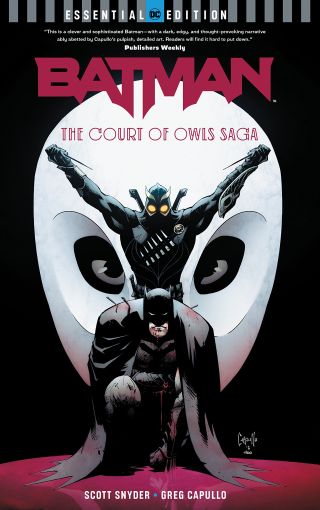
Kyle and I, when he took on Nightwing, we had been friends since we had already done Batman: Gates of Gotham together with Mike Marts before the 'New 52.' When I was doing Detective, we really became close during that period. He was coming into superhero comics around the same time I was. He's a terrific guy, terrific writer. We're still quite close. It was really such a collaborative effort. He was very supportive of the things that I was doing on Batman, and it was a matter of figuring out which pieces fit best where. How much to give in Dick Grayson's story? How much to keep in the Bruce story? It was a really positive experience.
Nrama: Greg, why do you think it was important to tell the 'Court of Owls' story in the beginning of both Scott and your run on Batman?
Capullo: I think because it completely unseated the character. In a way, that started him over. Batman was convinced that he knew Gotham inside out and upside down. Learning that the Court has been there for years, right under his nose, and he was completely unaware was a game changer.
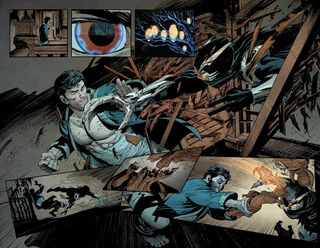
Nrama: Why do you think they were such intriguing antagonists?
Capullo: The Court's shadowy hold, hundreds of years of old, pulling strings with our hero being none the wiser is pretty compelling stuff.
Nrama: What went into introducing and creating the Talon for you two?
Snyder: I've always been fascinated by the idea that the natural predator of a bat is an owl. There's this deep, multilayered aspect to the relationship between owls and bats in Bat mythology already. Between old, forgotten stories about owl characters and the kind of strange, mysterious aspects of the Wayne's family history. Then some things that were pointed out by Grant Morrison when he did Earth 3 Crime Syndicate Owlman.
There's always been this hint that there's this secret that has do with owls and bats in Gotham. So, I knew that was the iconography I wanted to use. It was funny because I actually had a big fight with DC about it at one point. It was one of my first of many big editorial fights I had during the course of doing this story.
I think it gave me a reputation for being a bit of a difficult person, but I was very convinced that it would be my only chance to write Bruce Wayne ever. That I was going to get kicked off or fired by the end of it. So, I might as well just give it everything I had and just put every personal sort of element into it to make it something I could really stand by.
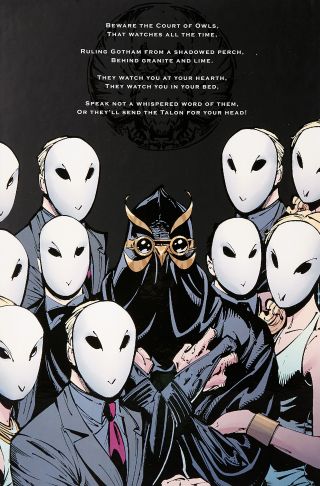
Where it came from in terms of the Talon, I was at a point in my life where I moved out to where we live now - about two hours outside of New York City; my wife was studying to be a doctor, and I was just getting into comics after doing prose. Comics had always been my dream. There were some aspects of my life that felt really settled and really excitingly inevitable. I had reached a certain point that I was beginning an exciting new chapter.
Then there were other aspects of it that felt really dizzying. Like when I came back to the city to go to the offices – the DC offices that used to be on 53rd Street. I grew up down on 23rd Street, not too far from those offices. And I'd sometimes walk down to where my father was working, still over on 34th Street, and those were my old stomping grounds as a kid that neighborhood around Murray Hill. I would go through there sometimes around the Seaport where we used to hang out because my sister was working down there too and seeing how dramatically the neighborhoods had changed and how nothing I knew as a kid was still there, like literally almost nothing. It was really disconcerting and it just created this uncanny feeling of placement.
And I remember thinking to myself, I was at a crossroads in my life that time where we just had our first kid, and we were thinking about having a second. I tried to really put that into this story. Batman really knows Gotham in this moment better than anybody ever. The way you know your neighborhood when you're a kid; it's made up of the people that you care about. It's made up of you and your friends. It exists as an imaginary thing that you make real by force of will and imagination together. But once those things change or the people are gone, that neighborhood no longer exists, even if the buildings and things are still there.
I realized that the way to hurt Batman, to really get at him and tell a powerful story was through a dramatic and extreme version of what I was feeling. Where he might be so confident about the city right now, but if the city could show him, you won't know me in five years and you didn't know me five years ago. In doing that it shows him his own mortality and how small he is - it teaches him humility and that there's some mysteries you'll never solve. There are some things you'll never know. Then I'll have something very powerful. So, the Talon for me was the method by which to show him there had been a ghost shadow opposing figure, a predator, that mirrored him all throughout history, and that he only existed in this one minute.
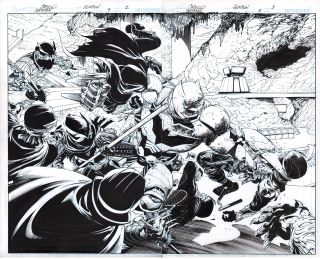
And if I could bring them all to life, and it all came praying upon him and hunting him. It wouldn't just be an army of zombie ninjas, you know, which they are, but it would be instead almost a hall of mirrors effect. Where he saw how much of the city he did not know, how much of it would always remain a mystery to him. So that was the power for me in both the court itself and the Talons. It was this kind of weaponizing of history saying you exist for just one moment, no matter how big you think you are.
The story is constructed like a concentric series of rings, but they move inwards. At first Bruce doesn't believe the Court exists. Well, they exist. Then he thinks they can't be too prevalent. Well, they have bases in his actual building. Then he believes it can't have to do with his own history. Then it has a lot to do with his history - Dick Grayson is in this. He's seeing his own family, where he might even have a brother. It's meant to destabilize him by getting closer and closer and closer, and the Talons for me are a function of that. They're a way of saying there hasn't just been one of these, but one of these in every era that you will never understand.
Nrama: Do you wish that DC used the Talon character more in 'Rebirth' and beyond? Do you want to work on the character more?
Snyder: The Court, I'm really happy with how they've been used.
I wish I used them more in certain ways. I had a second story with them. I was going to have them meet the King Owl. It really was a matter of just having two things. One, it was the deep belief that still finishing 'Court of Owls' that I wasn't going to get fired at some point. Both because of the arguments that I feel like I was having to protect elements of the story that had been agreed to. And I just didn't think you could get a long run. I just didn't think that happened.
Then the other reason, it's just I had other ideas and I felt worried that I wouldn't get to them. You know? I mean, there was a monthly schedule and you've got 12 issues a year and I wanted to do this two-part Joker story between 'Death of the Family' and 'Endgame.' I wanted to do what became Last Knight on Earth later. I wanted to do stories I never got to. There are still things I wish I had gotten to do there that I didn't. It was really just a matter of both fear of them taking me off the book and lack of real estate.
Nrama: This is a big, encompassing question – but you're very close with Greg Capullo. How did you form that creative process together?
Snyder: It's the single most important educational relationship of my life when it comes to comic making. Greg more than anyone has taught me how to write comics. When we came in together, he was used to a format - it was total outline. It was complete Marvel style, and for people reading this who don't know what Marvel style is it's when you summarize the main part of the story and then give a bit of an outline and let the artists kind of choreograph and dictate a lot of the action and then you come back in as the writer and dialogue it later. It's very collaborative and at different times it puts way more on the artist than the writer. It's any version that isn't an exact full script, you know, panel-by-panel. Like panel one, Gotham City raining at night. Panel 2 boots run across the rooftops. You're the director of that version.
I was used to the second and I was maniacal about the second having come off 'Black Mirror' and American Vampire. And what I didn't realize was that Rafael Albuquerque, Jock, and Francesco Francavilla really all liked full scripts and I was very flexible about it. I always told them, change whatever you want, and they did. But what I learned from Greg is that there are many others that don't like working full script and find it totally constraining and counterproductive.
We really butted heads at first. I don't know if I said this, but like I called DC publishers Dan DiDio and Jim Lee and I was like one of us are going to have to leave this book because I sent him a full script and he made a joke about how he ran out of printer paper printing it out because there were like 40 pages with all these references. He would do these things to poke fun. Like he's used a program to read the script that wouldn't see the references I put in. So, I would go out putting in all these references to historical things or to like the kind of car and he just wouldn't see it.
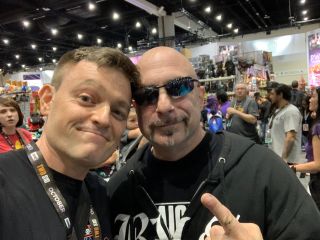
For those first weeks we really disliked each other. There's a very funny series of emails where we would be kind of beating our chest. Where he's like "Just give me what's important," and I'm like "They're all important, Greg." I'd go on to talk about how successful 'Black Mirror' was and he needs to give me more respect. He's like, "I'm sure your mother is very proud of you." We were really going at it, and I was positive we would hate each other and the whole thing would implode.
But what happened was we got on the phone, despite their efforts, they did not want us talking to each other because we were fighting so much. And I just called him up and I was like, "Look man, like I'm being honest with you, I'm just scared. Like I'm terrified of being on this book. I love your art, but I don't know you. It's totally different than the art that I've been working with. I've been working with mostly Vertigo style people. It was just wildly different."
He was honest. He was like, "Look, I'm scared too, man, to get on this book like this. It's a big gig. Just tell me what you want and let's see what I can do." I gave him the ideas about the Talons. I started talking to him about the owls, started talking about the look of our Batman – how he was young, how it felt fresh. The stuff he came back with was so good. It was just perfect. And I was like this guy gets it. It wasn't just the designs, he got the essence of it.
Very quickly I realized that Greg was somebody, no matter where he is in his life or his career, he will always be hungry and determined to do work that's the best of his career. And that is the absolute North Star compass for me as well, and why I stay with the people that I find that I love working with Jock, Rafael, and Francis, Jorge Jimenez - people I've been working with over the last years. They always want to top themselves.
Greg showed me how to adapt to different artists. It's issue #5 that a lot of people say is their favorite from 'Court of Owls.' It was around the time where we stopped fighting. I was always pretty far ahead - I was always neurotic about never being late with things. It was only about a month into when we were talking and stuff that I was working on an issue. But what I said to him was that this is one of these issues I could really use your help. You want me to loosen up? What if I loosen up and say this is the feeling I'm going for - here's the dialogue, the basic beats, but the feeling I need is the total disorientation, losing your mind, insanity. Can you do something that makes us feel like we're spiraling? And he came up with the idea to go full around with the book and DC really fought us on it.
They said people are going to think that it's a misprint. We were like "No" and Greg wrote this really passionate email. Like quoting Steve Jobs, it was like sometimes we must be foolish. And I was like yeah what he said. Then they finally said do it.
And the funny thing is we saw it in the PDF, and PDF you read vertically and scroll down. I was like, he didn't refrain from anything, it reads great. And then I got the physical book in the mail and my comp got a week before it came out on stands. I was reading it and turning the pages backwards to flip them. It was so awkward that I thought for a second it was a misprint and then it hit me and I was like "Oh God everyone is going to think it's a misprint."
They were right, we were wrong. And I tweeted out that everything in this issue is deliberate. Greg called me right away. He said "Don't say that, don't be afraid of it. You've got to own it." I'm like, alright. So, I deleted the tweet and then half an hour later he got his comps and I find his tweet that says "There's a god***ed misprint in issue #5." I had to call him and be like, "Greg, this is the right way – it's what we meant." So, he deleted that and he was ecstatic and was like it's even better this way.
It was a funny thing, but it was a moment that I'll always say in my career that was just incredibly important and a really big touchstone for me because it made me realize two things: give the artist the space that they want to have regardless of how much or little that is. They come back with things you've never imagined and are far better than you could have hoped for. Two, we acted as a team to DC and when we lock arms and say listen this matters to us. We're not going to do this if you don't let us. It really worked. So that's a tactic that I've used over and over again, unfortunately for them. But with every artist that I've worked with, if something is important to the artist it's important to me. We try to do that very sparingly, and only over things that really are key, but you do it and it really works.
Nrama: Greg, what was your favorite aspect of drawing 'Court of Owls?'
Capullo: Stripping Batman of his overconfidence and neatly breaking him in the labyrinth.
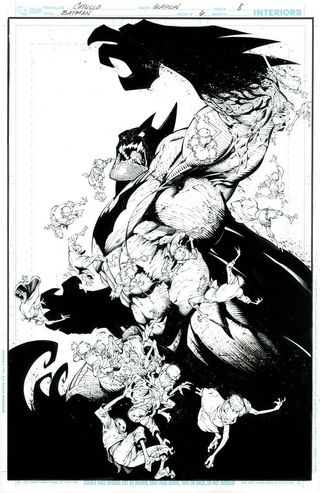
Nrama: What went into creating the designs for the characters that debuted here?
Capullo: Scott gives me notes in his scripts about what he's feeling. I take those seeds, plant them in my head and let my imagination and instinct grow the characters from the top of my pencil.
Nrama: For the two of you... Looking back, do you have a different feeling towards the story compared to when you were so closely working with it?
Snyder: I re-read it recently, and I was really proud of it. I don't have a different feeling about it other than pride and gratitude to have the chance to do it, honestly, to both the fans and DC. My friends like James Tynion IV and people who have known me for a very long time would corroborate - I've always believed deeply that the key to being able to do what you want in the books is your relationship to your fans, not to your editors.
For awhile I was pretty rough at DC, especially during this arc, especially during this story – I'm not saying I didn't care about my editors, but it matters a lot more to me that the fans liked what we were doing than the editors liked what we were doing. To some degree, that's still the case. Now I work with editors who see eye-to-eye. I listen to everything they have to say and their advice is priceless a lot of the time when it comes to making the story a more refined and expressive version of what I'm trying to do.
But at that time, it was more like if the fans like it and like me and Greg - that would give us the ability to do the story that we want because of the sales. Seeing people respond gave us the audacity to do that story. I'm really grateful. But I just wish I had more fun. I wish I could go back and tell that person from like almost 10 years ago now it's going to be okay, enjoy it, enjoy doing this because it's a great moment. It's not just a terrifying moment. Don't be so angry, freaked out, scared, and anxious all the time. Just try enjoying it.
Nrama: What do you think of other mediums adapting Court of Owls – like Gotham and the DC animated films. Would you like to see this more?
Snyder: I'm always up for it. I always love it when someone takes something we've done and makes it their own. People often ask me if I get upset if something isn't a religious adaptation, following the guidelines that we used in the books. But I honestly prefer the opposite. I love when people take our creations and then adapt them to their own needs. I love seeing the Court reinterpreted however anyone wants to and I hope to see it interrupted many more times.
Capullo: Beyond flattering. Yes, of course. Especially, if I get some money out of the deal.
Nrama: Would you like to return to the Court of Owls in some shape or form?
Capullo: Not at this point. What I mean is, Scott and I intended for Last Knight on Earth to be the end of "our" Batman that we began with in 'Court of Owls.' Otherwise, absolutely!
Kat has been working in the comic book industry as a critic for over a decade with her YouTube channel, Comic Uno. She’s been writing for Newsarama since 2017 and also currently writes for DC Comics’ DC Universe - bylines include IGN, Fandom, and TV Guide. She writes her own comics with her titles Like Father, Like Daughter and They Call Her…The Dancer. Calamia has a Bachelor’s degree in Communications and minor in Journalism through Marymount Manhattan and a MFA in Writing and Producing Television from LIU Brooklyn.
